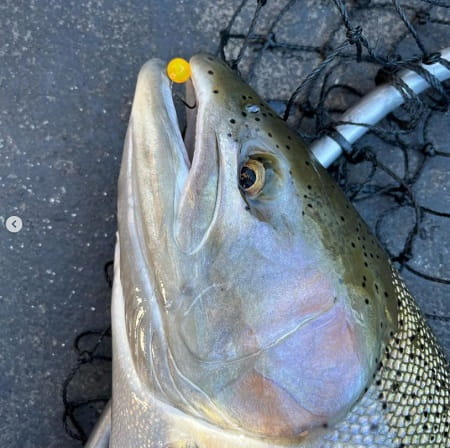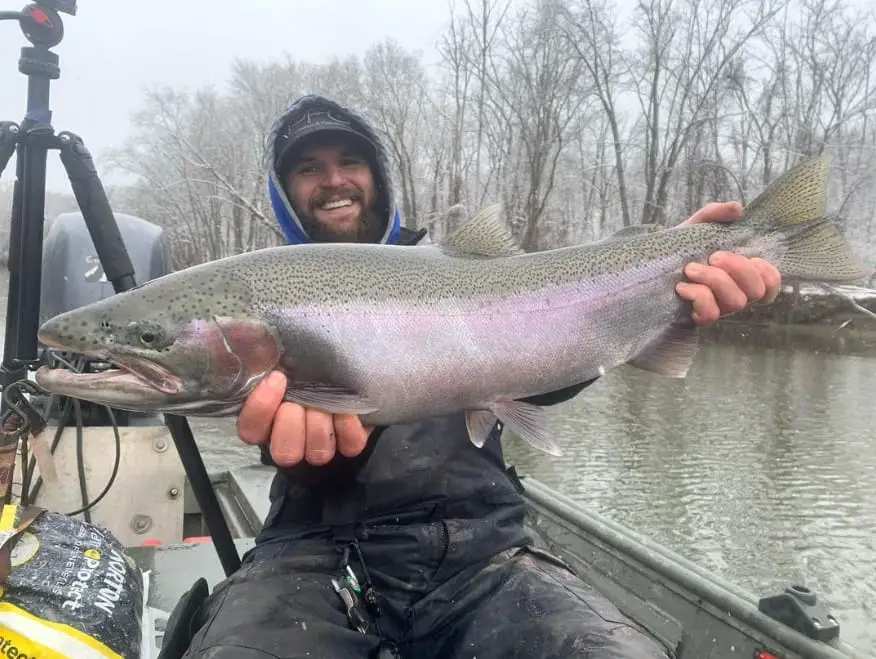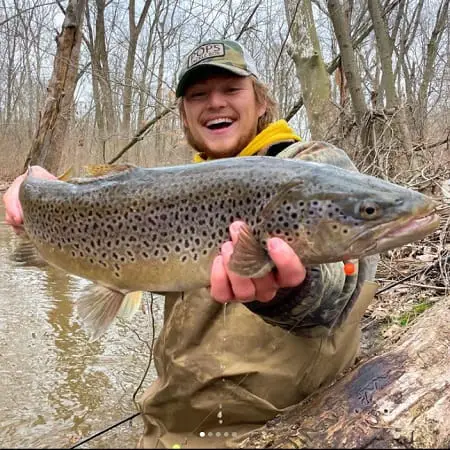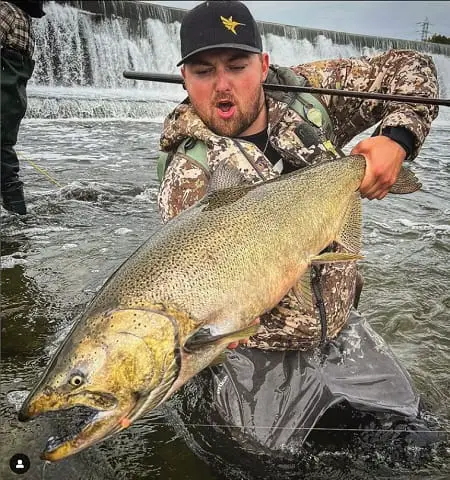Bead Fishing – Full Article
I have been guiding and fishing with beads for steelhead, trout, and salmon for over 20 years and trout beads are still one of my most effective baits. In this article, I will share my best trout bead types, sizes, colors, and rigging methods along with a tip on changing trout beads quickly and easily.
Fishing with trout beads is a great way to catch more trout and steelhead in rivers because trout beads imitate the fish eggs that trout and steelhead love to eat. Fishing with trout beads has become very popular and is a great alternative to using real fish eggs as bait.
Some call them steelhead beads, others call them trout beads, and some just call them beads. Beads come in glass or plastic and they come in a few sizes with lots of great color options. There are also some hooks that work well with beads that you should know about and I discuss all of this below.
Watch for my guide tips and advice which is based on thousands of hours of guiding clients with beads. This is advice and tips you won’t find anywhere else.
We may make a small commission from some of the links on this website, which is at no cost to you. I appreciate your support. Learn More
Fishing With Beads The Right Way
I and many other river guides around the Great Lakes region will have their clients fishing with trout beads when targeting trout, steelhead, and salmon in rivers.
This is simply because trout beads can be very effective when other baits just don’t seem to be working.
I think it’s the way we rig them and the fact that a tiny little bead is less intrusive than other bigger or more popular baits, and sometimes, especially when fish are being heavily pressured, or bombarded by many large spawn sacs, a less intrusive baits is required to get them to bite.
Knowing how to set the trout beads up and when to fish with trout beads is important which is why I will give you the same tips and advice on fishing with trout beads that I give to my clients and friends.
I will show you how to rig them up, the different ways to fish with beads, as well as what hooks to use when fishing with beads.
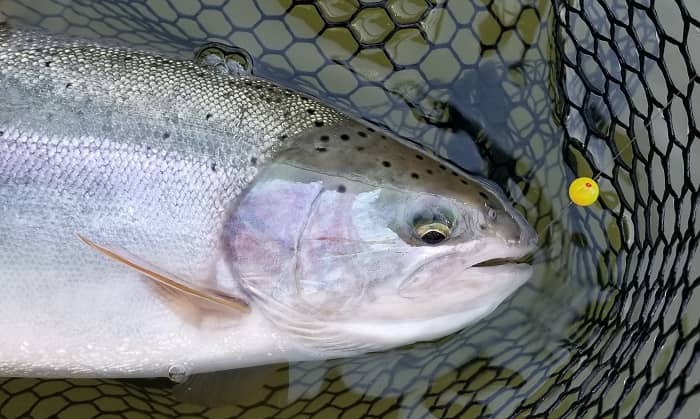
This article is a combination of fishing with beads for trout, steelhead, and salmon because I fish them all the with the same methods and rigging.
The only difference is that I might use a much bigger and stronger hook when fishing for salmon than I would when fishing for little brook trout, but both brook trout and salmon will eat the same sized bead and therefore they can be fished the same way.
I may also fish trout beads a little differently based on bigger or smaller rivers and will often use lighter lines for trout. I discuss my specific methods for trout on my page Bead Fishing For Trout – Easy Guide Secrets.
Steelhead Beads – Also Known As Trout Beads
Some anglers will know them as trout beads because there is a brand that I use called TroutBeads and also because they are used for trout fishing.
Other anglers will refer to them as steelhead beads, but whatever you call them, they are all basically the same thing and they can be used for fishing for trout, and steelhead and can also be great for salmon.
Trout and steelhead beads are hard and come with a very small hole in them so they can be slid up the line and fastened onto the line and not onto the hook. There are also soft trout beads and I will discuss them and their pros and cons.
Steelhead Bead Sizes
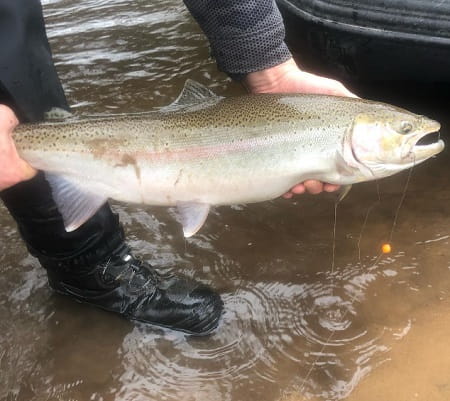
Steelhead beads come in 4 different sizes which are good for clear to dirty water situations.
A 6mm bead is about the size of a typical egg from a brown trout or rainbow trout and an 8mm bead is the size of a typical salmon egg.
I and many other anglers tend to use the 8mm beads the most around the great lakes rivers where salmon exist but this size will also work in any river whether salmon exist or not. The 8mm size is good for clear to slightly colored water conditions and in faster water situations.
The bigger trout beads get seen better in faster flows and therefore get picked up by the trout more often.
I will drop down to the smaller 6mm steelhead beads under very clear water conditions or during the spring when the steelhead or rainbow trout are spawning.
If the water becomes dirtier or is slightly off-colored I will go up to a 10mm or even the 12 mm steelhead bead size. I rarely fish the 12mm beads unless I’m fishing very big fast water or it’s very dirty.
Best Steelhead Bead Colors
The best steelhead bead colors are often shades of yellows, oranges, and pinks, however, the colors that will work the best will depend on the clarity of the water and the light conditions.
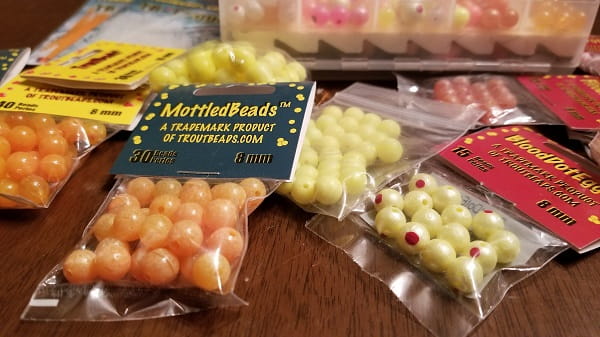
Different brands of trout beads will have different names for their colors. I cover those best colors down below in the section on plastic steelhead beads and glass steelhead beads.
Trout bead colors can also come with some unique patterns.
Common patterns are mottled trout beads which give the bead a cloudy or milky look. Some trout beads also come in what is called blood dot beads which have a red painted dot on the beads which is thought to attract the fish.
Best Hooks For Beads
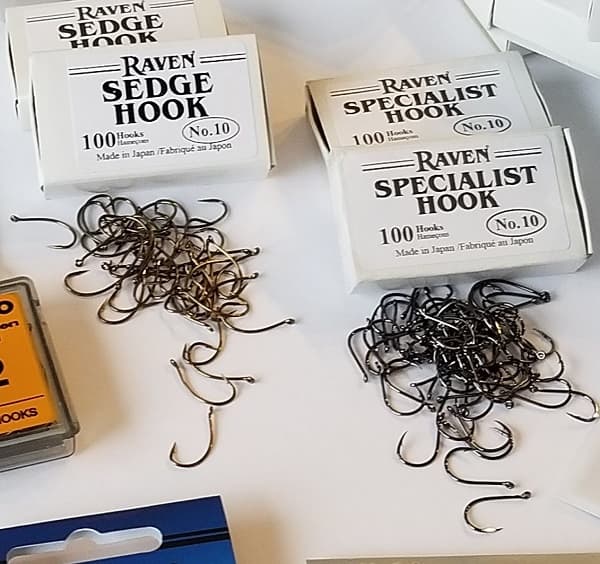
Fishing with trout beads requires the right hook size and shape and some of the best hooks for fishing with beads are the Raven Sedge Hook or the Raven Specimen hooks.
I use the same hooks for steelhead as I do for trout but I change the sizes of hooks based on the size of the trout bead, the speed of the current, the depth of the spot, and the clarity of the river.
I use hooks between a size 8 and a size 12 for both steelhead, trout, and salmon. I rarely go smaller than a size 12.
There is no need or benefit to go to a hook smaller than a size 12 even if the steelhead bead is as small as a 6mm bead.
I prefer not to use a hook bigger than a size 8 in clear or slow-moving water because hooks bigger than that can weigh the trout bead down too much preventing a natural-looking drift, and also because the fish might see the hook and not hit the bead.
If I had to choose one hook size for all trout beads and for all conditions I would go with a size 10 Raven sedge hook. The reason this is my go-to hook is that it’s a great hook when I need a stealthy lightweight hook but will it also work in dirtier water.
However, I find that the Raven Specimen hook does hold onto fish better so I use it when a stealthy hook is not required.
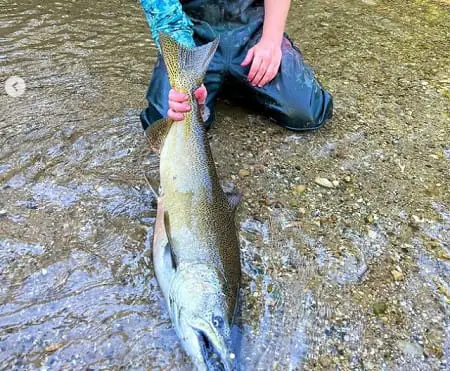
I also use Specimen hooks or a stronger hook when fishing for salmon. The Raven Sedge hooks are not strong enough for salmon.
For many anglers, beads are the hottest bait for salmon and even huge salmon will eat the smaller 8mm beads.
There are other great hooks that I would use with trout beads, and there are some bad hooks that I would never use. Check out the best hooks that I use which are also tested and proven to work well with steelhead beads, see them on my Best Hooks page
In dirtier or faster water, I may up-size my trout bead to a size six or maybe even a size four because the extra weight of the bigger hook can help you get your bead down to the fish faster.
In dirtier and faster water, it’s less likely that a fish will see the hook, too so a big hook works in this case. The other reason I may go to a bigger hook in faster and dirtier water is that a bigger hook tends to hold better once the fish is hooked.
If you find that you are hooking and fighting fish but a lot of them are coming off, meaning the hook tears out, you probably need a bigger hook, or you need a different hook shape.
Some of the best hooks for beads are:
- Raven Sedge Hook – get them at FishUSA.com – HERE
- Raven Specimen – get them at FishUSA.com – HERE
- Gamakatsu – get them at FishUSA.com – HERE
- Blackbird – get them at FishUSA.com – HERE
Steelhead Beads – Fishing For Steelhead With Beads
Fishing with trout beads for steelhead is no different than fishing with beads for trout or salmon unless the water that you are fishing is different.
Very small trout streams may require a slightly different setup and presentation in a 5-foot by 5-foot spot that is only 2 feet deep, compared to a bigger steelhead spot that has lots of current speed and is 20-foot wide by 100-foot long.
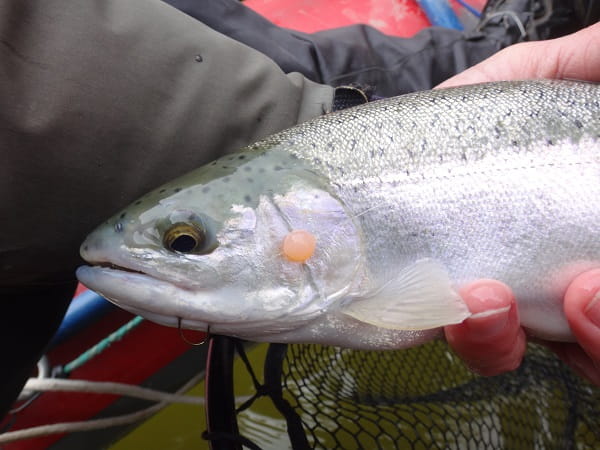
If I’m fishing with trout beads on bigger rivers I will use a float to suspend the beads just off the bottom.
The float allows me to drift the trout beads down to the fish, control the speed of the bait, and it allows me to cover the water well.
There is a lot more to float fishing than just watching the float drift down the river, and anglers that understand this will catch far more fish. There is a reason why fishing guides do things a certain way. Check out my float fishing page so you know how to do this well.
If you are going to use a float, which to some is known as a bobber, I recommend using the right bobber size and style for river fishing.
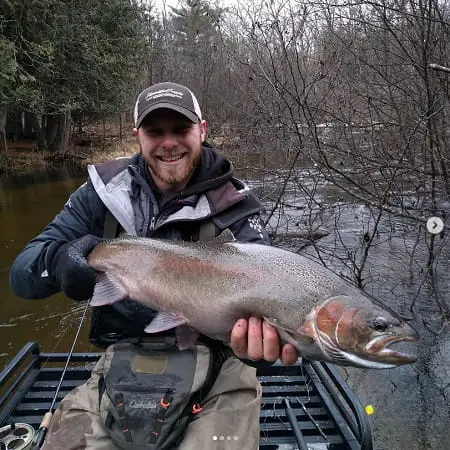
If you use the wrong float you may limit how many fish you will catch. Check out my Best Floats page.
I will use the same steelhead beads, the same hooks, and often the same presentation for trout, steelhead, and for salmon and only change the way I’m fishing with beads based on the type of water, speed, and depth.
If you want to see how well beads fish when compared to the more popular spawn sacs, check out this awesome video from SBS Outdoor Action, where John from Gent Bent Guide Service competes to see what works better for steelhead.
Which do you think will catch more steelhead?
You might be surprised. Watch Now! Winter Steelhead BOBBER DOWN CHALLENGE! – Beads vs. Bags (Surprising Results)
Trout Beads – Fishing For Trout
Fishing with trout beads is a great way to catch steelhead, but because some trout rivers can be much smaller, they will require adjustments in your presentation and in your setup so you catch more trout.
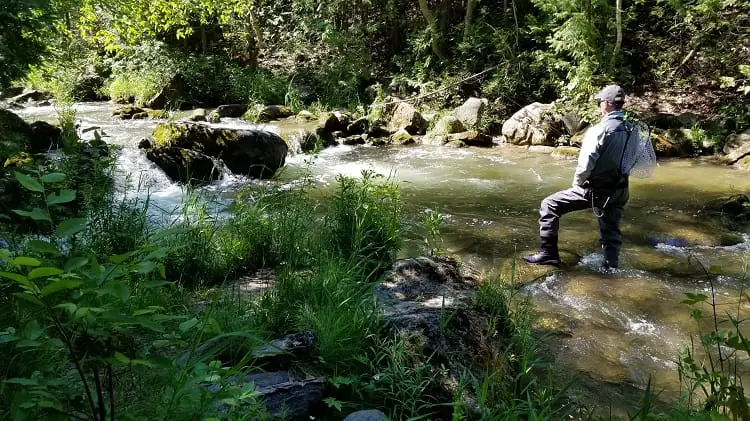
Since using floats in shallower runs and pools doesn’t always work so well, the best method for trout fishing with beads in this type of water is to use an advanced bottom bouncing method. You can see how to do this on my page on Bottom Bouncing.
With the advanced bottom bouncing method, you can easily adjust for shallow waters that are 1 foot deep to spots that are over 4 feet deep with nothing more than lifting and lowering your rod tip.
You are also able to fish 3 foot long pockets or 25 foot long pools using this bottom bouncing method.
Plastic Beads
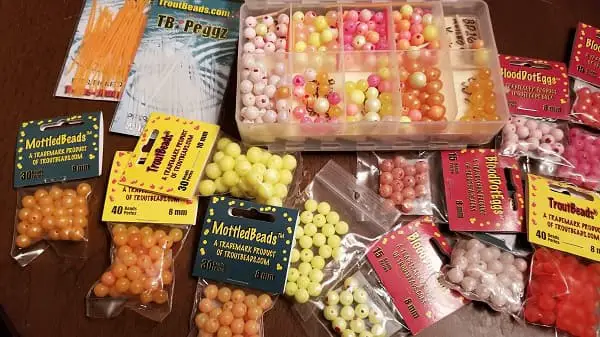
Plastic trout beads are by far the most common types of steelhead beads because they are readily available and they are cheaper than glass beads.
I use the Trout Beads brand with great success and mostly use the 8mm size.
Plastic steelhead beads also come in lots of great colors and 3 or 4 good sizes.
When trout fishing with beads I prefer the plastic ones because the rivers are not as deep and the plastic beads don’t need to get down as deep. This is helpful because you don’t want to drag the bottom with your trout bead.
The best plastic beads are from a brand called TroutBeads, and you can get the best price on individual packs at FishUSA- Here or get a variety pack at FishUSA – HERE
Clear Water Use: 6mm and 8mm | Medium Clear Water Use: Size 8mm is best | Dirty Water Use: Size 10mm or 12mm |
Peach Roe | Egg Yolk | Chartreuse |
Salmon | Natural Roe | Hot Cherry Roe |
Glow Roe | Orange-Clear | |
Peach Fuzz | Gold Roe | |
Apricot Swirl | Mottled Natural Roe | |
Gold Roe | Pink | |
Milt Roe | Cerise |
Glass Beads
Some anglers swear that glass beads are much better at catching trout, steelhead, and salmon than plastic trout beads, and in my opinion, glass beads probably are better than plastic beads, but only because of a fault in the angler’s presentation.
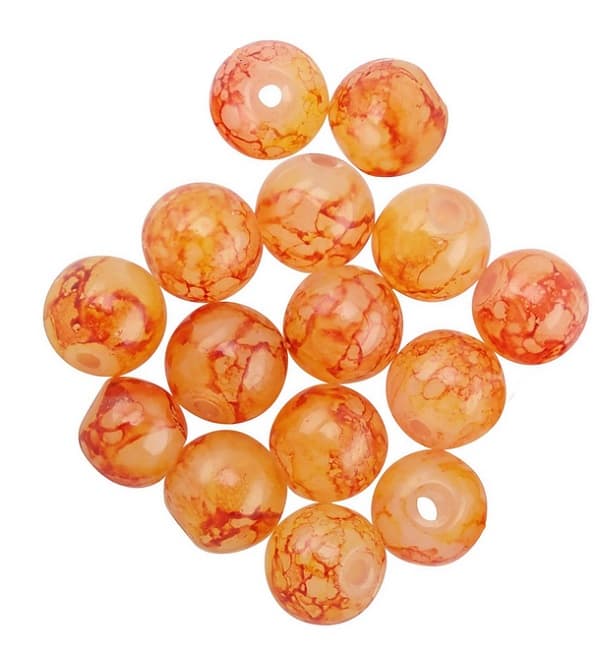
Glass beads are much heavier than plastic beads so they get down fast.
I do not believe that glass beads are actually better than plastic beads for any other reason then they sink and get into the strike zone faster and they stay there longer.
If that is the only reason why glass beads are catching more fish, then anglers that are catching more fish on glass beads might have a problem with their leader setup or their presentation and that could be causing them to miss fish when using other baits.
If you are catching more on glass beads than plastic beads, you might want to consider that there is something wrong with the way you are presenting your bait and figure out how to fix this so you will catch more fish when using lighter baits.
If you have to rely on a heavy bait to catch more fish you may be missing out on fish with other lighter baits.
Other than the weight, glass trout beads and plastic trout beads are the same! They feel the same, they even look identical to me and to the fish, they are both hard as a rock, and they both do not have a scent that would attract more fish.
There is no other reason for glass beads catching more fish than the plastic beads except for them getting deeper or maybe having a slightly different sound when bumping the rocks on the bottom which could be a possibility except that anglers fishing sandy bottom rivers with glass beads also claim better results with glass beads.
If you are catching more fish on glass beads I recommend considering increasing your depths with other lighter baits and getting those baits deeper with more weight on the leader which will likely improve your success with them.
This may mean your will need to set up your leaders better so that you can get any bait down and deeper just like the heavy glass beads do.
Check out my leader setup page.
Trout bead colors and bead sizes can make a big difference when fishing with beads and will affect how many fish you catch. In clear water, I use a smaller beads in natural colors, and in dirty water I will use bright colors and bigger beads.
The best trout beads on the market come from CreekCandy Bead Company and you can get them at FishUSA.com
When fishing with beads, I change my sizes based on the conditions. See the chart below for sizing and the best colors to use.
The Best Glass Steelhead Beads Are:
Clear Water | Medium Clear Water Size: 8mm and 10mm | Dirty Water - 12 inches or less vizability Size: 10mm or 12mm |
Clearwater Candy Corn | Natural Honey | Frosty Chartreuse Hyper UV |
Clearwater Atomic Peach | Tequila Sunrise | Blood Shot Embryo |
Clearwater White Widow Hyper HD UV | Blood Shot Candy Corn | Clearwater Atomic Chartreuse Hyper HD UV |
Frosty Brown Roe Hyper UV | Bow Roe Hyper UV | |
Natural Sucker Egg | Toxic Berry Hyper UV | |
Blood Shot Candy Corn | Trout Crack Hyper UV |
Securing Beads To The Line
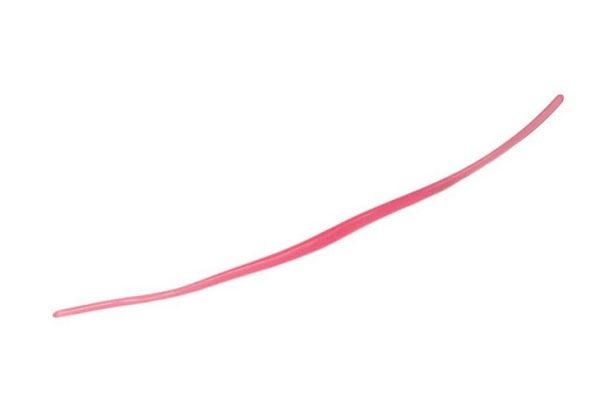
You can secure the beads to the line using what are called rubber bead pegs. You can also secure the bead with a toothpick, or with bobber stops, or even with small rubber bands.
For proper bead placement see below in the bead rigs section.
Check out the rubber band method on YouTube. If you like this method, you will need this banding tool from FishUSA.
There are also some knots that anglers will use to secure the beads to the line. You can see the bead knot method on YouTube
I prefer the TroutBead pegs from FishUSA.com over all other methods for securing beads to the line because they allow the bead to slide down when a fish has it in its mouth for a better hook set.
Bead Boxes
I put all my beads in a trout bead box. One of the best boxes is this large TroutBead box from Fish USA.com.
Soft Steelhead Beads
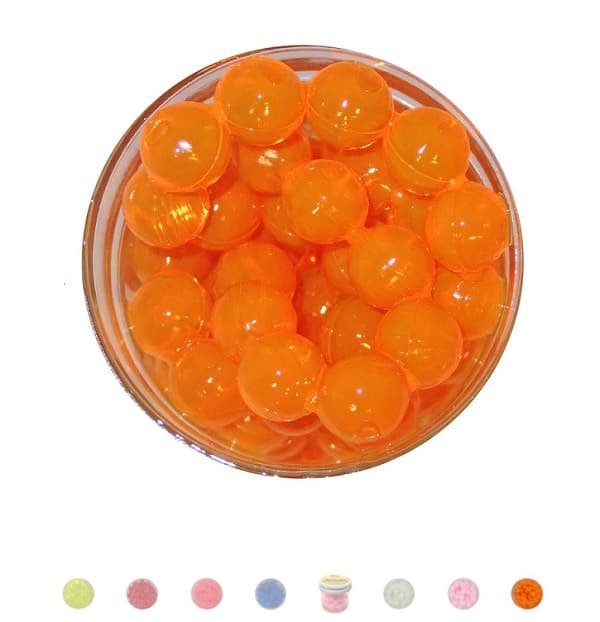
Soft steelhead beads are made out of softer plastic or rubber and they can also be a good bait for catching catch trout, steelhead, and salmon.
Soft steelhead beads go on the hook instead of on the line and can be removed and changed more easily than hard beads.
Trout and steelhead may hold onto soft beads longer, but they may also see the hook easier through the translucent bead and then avoid eating the soft beads.
There is a way to attach a soft steelhead bead on the line similar to how we rig the hard beads. You can see how to do this on YouTube – HERE or for an easier method, see this video – HERE
Soft beads are not used as often on the rivers because most guys feel that they’re not effective as hard beads. However, soft beads can be very effective, and they are worth a try.
Death Roe Beads: Premium Soft Beads
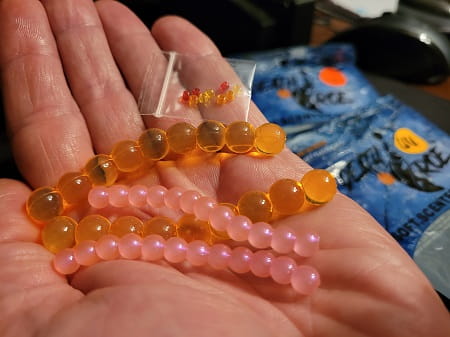
A very popular soft bead that I have used and like a lot is the Death Roe Soft Beads.
These scented soft beads come with micro hard beads for a special setup.
You can see the small package of microbeads in the image. See that bead setup HERE.
Some of the best soft beads are:
- Berkley Gulp! Alive! Floating Salmon Eggs – get them at FishUSA.com or at Bass Pro Shops – HERE
- Berkley PowerBait Magnum Power Eggs – Get them at FishUSA.com – HERE
- Magic Salmon Eggs – Get them at Bass Pro Shops – HERE
- Atlas Plastic Eggs – get them at FishUSA.com
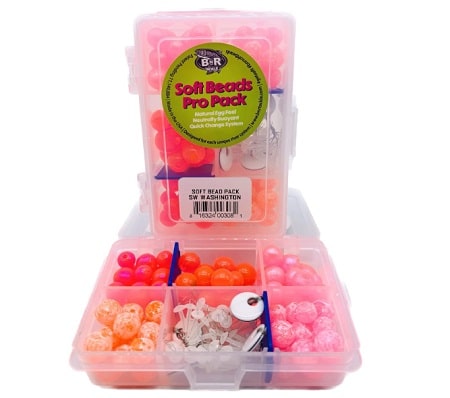
BnR Tackle Soft Beads Pro Pack
This is a great soft bead pack that comes with a quick change rig system that some guys really like.
These soft trout beads look like reel eggs and they feel like them too. They are neutral buoyancy with a self-closing center hole for easy rigging.
How To Rig Beads – 3 Best Bead Rigs
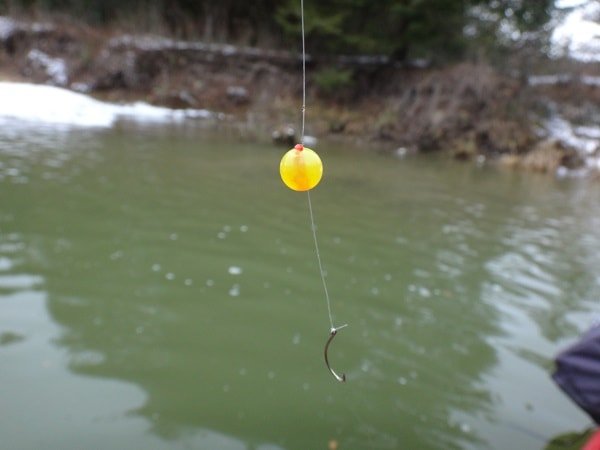
When fishing with beads, I always position my bead 1.5″ to 2″ inches up from the hook for two reasons.
First and most importantly, the hook is less likely to be seen by the fish when it’s farther away from the bead, which means more hookups.
Second, as the fish tries to inhale the bead the hook almost always gets caught on the outside of the lip which self hooks the fish which then decreases my chances of losing a fish to them spitting the hook out too fast.
If I go any longer than 2 inches, I have found that I may miss more fish because the hook is too far away from the fish to self hook them.
Even if the bead is in their mouth the hook may not be in the mouth if it’s too far away because most fish will not swallow a hard bead deep enough to get hooked. And if you do hook a fish with the hook over 3 inches from the bead I tend to hook too many fish in the eye or the gill plate area which is not a good spot for holding onto the fish and you will lose more fish.
If I go shorter than 1.5 inches or with the bead touching the hook, I tend to find that the hook goes too deep in their throat, which makes it harder for releasing the fish unharmed or for just getting the hook out at all, which is why I never advise putting the hook and the bead too close together.
Some river guides believe that the hook too close to the bead will be seen too easily and then the fish won’t bite it. They also believe that the bead can act as a leverage point at the lip and the hook can come out easier. I think that both of these things are possible, which is why I always have my hook 1.5″ to two inches from the bead.
I have also heard some people saying that a bare hook is considered snagging but in this case, there is never the intention to snag a fish, and since the fish are actually trying to eat your beads, it’s not snagging.
In my opinion, having the hook away from the bead is better for the fish because the hook usually gets caught on the outside of the mouth instead of deep in the throat of the fish.
Should your country, state, or province have rules that do not allow a bare hook to be used like this, some anglers will tie a piece of thread or yarn onto the hook so the hook is no longer bare and is now considered legal. If this is a concern in your area please check with your fish and game department to be sure.
Single And Double Bead Rigs
When fishing with beads, I will use a single steelhead bead rig in water that is 3 to 8 feet deep, but when I fish water that is 4 to 10 feet deep, I will often use a double steelhead bead rig so that I can cover the bottom and cover higher up in the water column.
With the double steelhead bead rig, I will often use two different bead colors to see which one the fish prefer. If one color gets hit more than the other color it could mean that the fish prefer that color. But, it could also mean that that particular bead they want is in the strike zone more often than the other bead, so it gets hit more.
If one bead is getting hit more often, instead of putting on two beads of the same color, I will keep switching the bead color on the one that doesn’t get hit until I find a color that they want. This way, I have two colors on the line that are hot colors. You could also run 2 of the same colors if you wanted to see if that works.
Steelhead Bead Setup
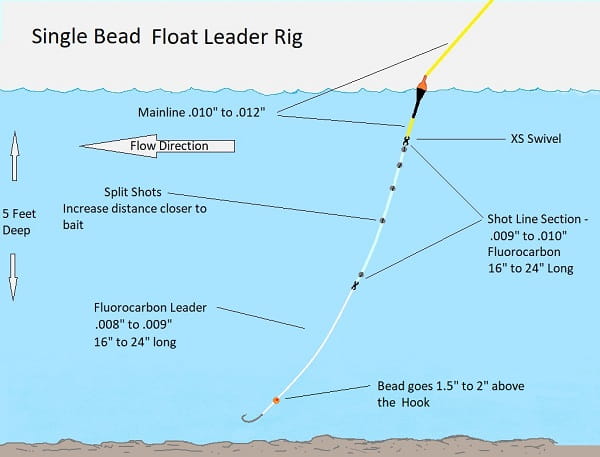
This is my standard single trout bead rig that I use when guiding for steelhead or for trout on very big or fast rivers.
For trout, I will drop down to a 3 to 6-pound leader section at the bottom and for salmon, I will go up to a 10 or 12-pound test leader.
This is the same for the leader diagram below.
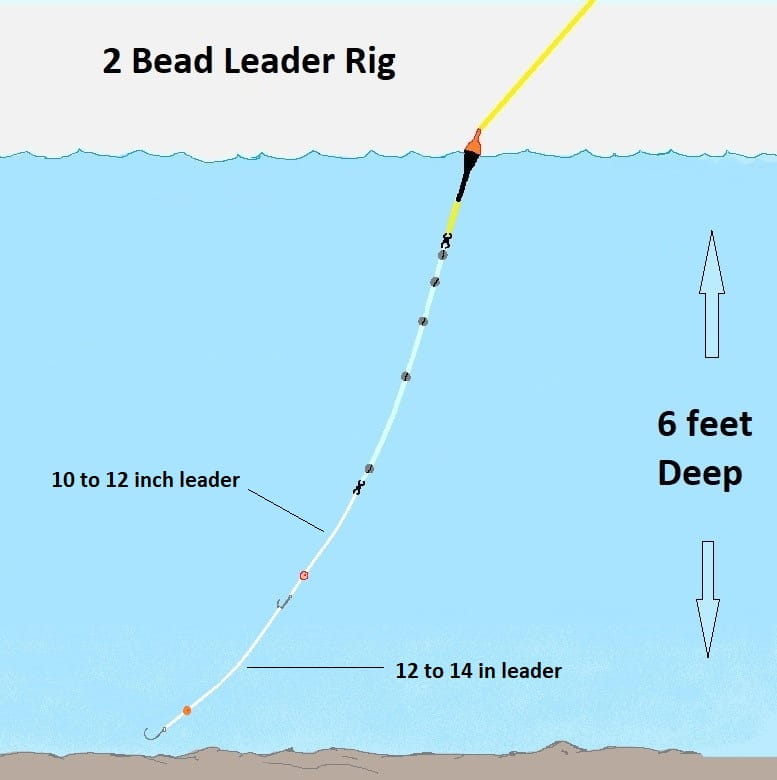
This is the two-bead rig that I use when I’m guiding.
You could add a bead and bait combination instead of two beads.
It is up to you to experiment with which bait goes where but my rule of thumb is that my confidence bait goes on the bottom.
Trout Bead Setup – Bottom Bouncing Rig
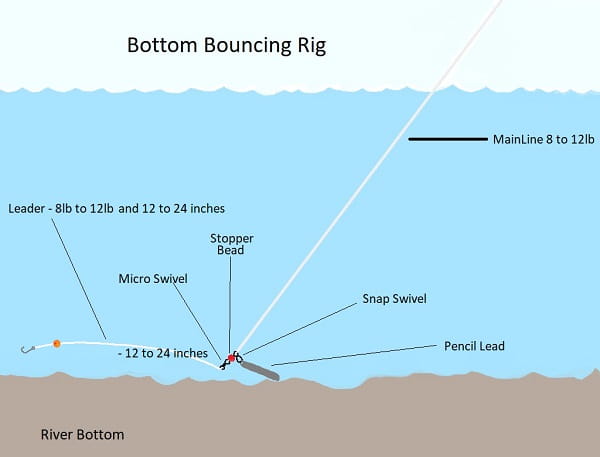
This is a traditional bottom bouncing rig that I use as a steelhead bead rig when fishing with beads in shallow and faster pools.
It can also be used in deeper and bigger rivers that are too deep for float fishing.
There are some other variations to set this up and to fishing with it which can be seen on my Bottom Bouncing page
Shallow Water Bead Setup – Advanced Bottom Bouncing Rig
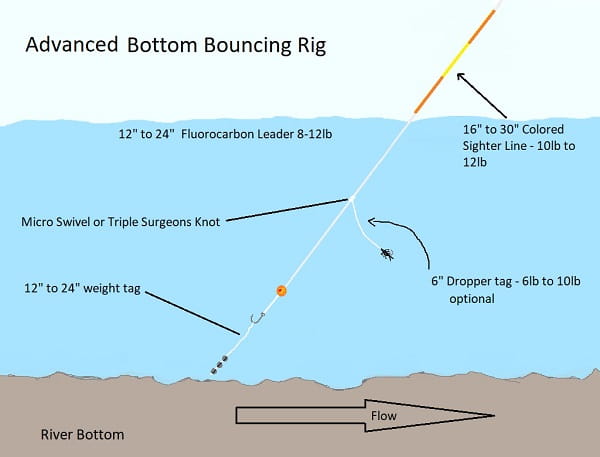
This is my most productive steelhead bead rig when I am fishing with beads for trout or steelhead in smaller to medium-sized rivers where there is a lot of pocket water and shallow runs.
This steelhead rig is an adaptation of an advanced nymphing setup used by myself and by world-champion tournament fly anglers around the world.
This method is better than any other method I have used when fishing with beads in spots that are 12 inches to 4 feet deep.
This method gets your bead 6 inches to 1 foot off the bottom almost all the time which is where most fish feed. The added sighter up the line allows you to adjust your depths and see even the subtlest takes from trout and salmon.
How To Fish With Beads
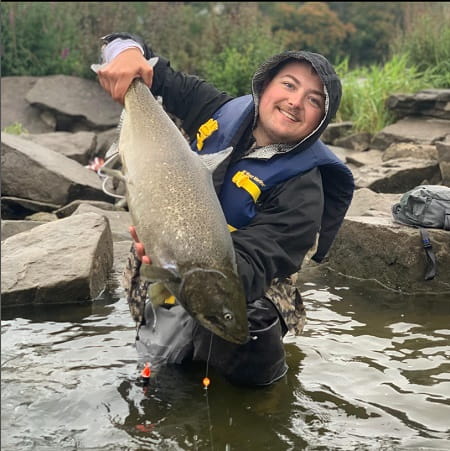
Fishing with beads can be done using spinning reels, a baitcasting reel, or many guys that Centerpin Fish will use beads.
If you want to learn to Centerpin fish better check out my page on Centerpin Fishing For Beginners.
There are two main methods when fishing with beads in rivers that I teach my clients.
Fishing with beads either requires using a float also known as float fishing or doing something known as bottom bouncing. Both these methods are great for catching trout, steelhead, and salmon in rivers and I will discuss them further below.
It is not advised to fish with beads that are stationary and held on the bottom by a heavy weight since the bead is hard, has no scent, and may be picked up and then spit out within seconds.
When fishing with beads, you need to set the hook faster and more often since the steelhead beads are hard as a rock and the fish will pick them up and try to spit them out within a second or two. If you are slow on your hook sets you may miss more fish.
It’s also not advised to trot or check your steelhead beads too far ahead when using a float for the same reason.
If you are fishing with beads and you check or trot your bead way out in front of your float they will grab the bead and then spit out the bead before the float even moves, and this means you won’t even know that they were there. This happens more often than anglers realize when they trot too much with artificial bait.
If you are not sure what trotting or checking a float is and you want to know more about float fishing or better float and leader angels that will ensure that you catch more fish check out the page on Float Fishing.
Quick Change Trout Beads
One of the big downsides to fishing with beads is that in order to change your bead you often need to cut the hook off, then slide the bead off, then put a new bead on, then secure it in place, and then tie the hook back on.
That ends up taking a lot of time that could be better used to catch some fish. And on very cold days it’s even tougher to do when your fingers are freezing.
That is why I and many guides and serious anglers that I know will pre-tie our bead rigs.
A pre-tied bead rig, also known as a bead leader, allows you to quickly make a change with only one knot.
I simply make up 10 to 20 pre-tied bead rigs when I’m at home and I secure them to a rig holder like the Lindy Rig holder in the picture below. You can usually get the Lyndy Rig Holder at this link.
I make my bead rig leader about 14 to 16 inches long. Remember that you might lose an inch or two when you tie it on so keep that in mind.
I will often double up this 12-slot rigger, or I will have 2 or 3 of them for different-sized beads and different colors.
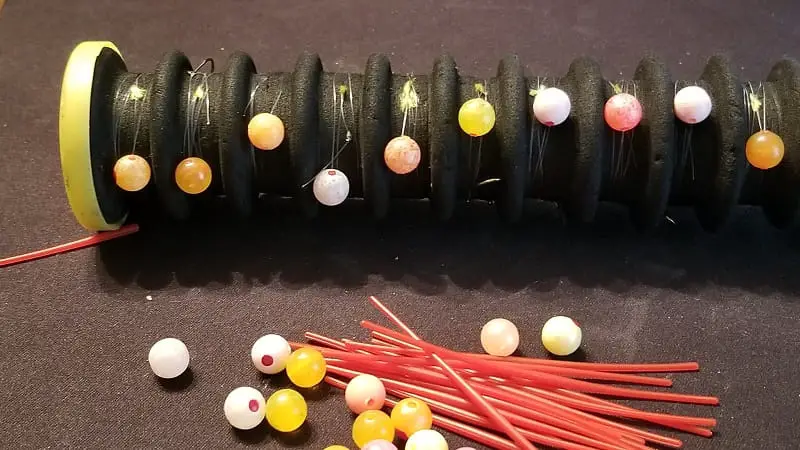
Bead Storage And Organization.
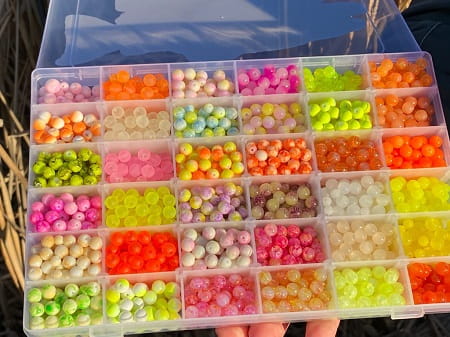
I have a ton of beads!
Lots of colors, sizes, and types of beads for all the different conditions. There is no way I could bring all my beads with me on a guide trip.
At home, I store all my beads in large bead boxes.
On the river, I only take what I call day boxes which is just enough of an assortment of beads to last a few days or more, and as the colors deplete, I just add more.
These day boxes are small enough to fit into a fishing vest pocket or a fishing pack.
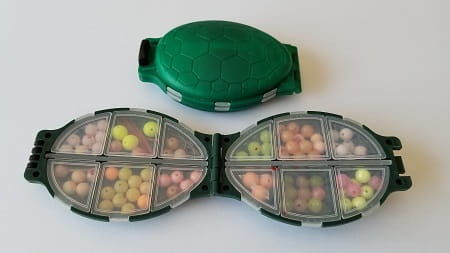
Guide Tip: Use a bead box that has each compartment covered.
This way, if you drop it you won’t be spending the next 30 minutes picking up all your beads, and you won’t need to reorganize all of them.
Imagine me or one of my clients accidentally dropping that big bead box shown above onto the rocks, I’d be there for hours picking up beads.
Setting The Hook Issues and Fixes
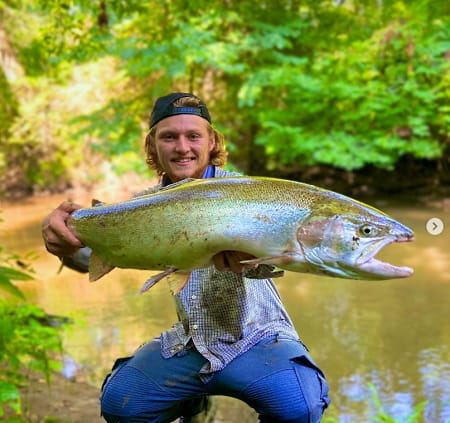
Some anglers find they miss bites or fish come off more often when using beads. I don’t have that problem, and I will tell you why!
In this BONUS section, I have listed things to try should you find yourself missing fish, or losing fishing.
First, understand this – most of the beads that angler use are hard as a rock and any fish that puts it in its mouth is going to spit it out fast. So, your need to SET HARD, SET FAST!!
On the river, I would explain it to my clients like this.
“If you were talking to me and a fly flew into your mouth how fast would you spit it out? That’s how fast a fish can determine that a hard bead is not edible and how fast they will spit it out.”
So, if you find yourself missing bites or the fish are coming off, consider these things.
Fixing Hooking Issues
These are the things I would consider if a client of mine was having issues on the river.
- Shorten to 1.5-inch gap between the hook and the bead.
- Ensure you are using a good wide gap hook like the Raven Specimen hook.
- Personally, I use size 8 and 10 hooks 95% of the time so if you are using a bigger hook or a smaller hook maybe try one in this size. Remember, the smaller the hook the thinner it is and the easier and better it penetrates. But, hooks that are too small grab less flesh and are more likely to tear out.
- I am trigger-happy with hooksets, especially when it comes to beads and yo should be too.
I’ll occasionally fish while my clients when they taking a break or eating their lunch or chatting on the phone. They will often watch me as I fish and I have been told many, many times by these clients that they didn’t even see the float go down yet I set the hook and there was a fish there. And they were right, the float did not go down!
That’s because I’ll often set the hook before the float ever goes under.
I’ve watched thousands of floats go down and there is often a slight twitch the float makes before it drops, especially in slower water. That twitch is the fish closing their mouths on the bait which means the bait is already in their mouth.
I set the hook on that twitch all the time!! The bait is already in their mouth completely, so why wait? Don’t wait for them to spit it out.
FYI- I’m not knocking the skills of this angler at all, he’s a very good angler and I work with him on this website.
To see what I mean, watch the bobber-downs in this video, see the second bobber-down at about 1:04 minutes in the video link below. I knew the fish was on the bait and would have set the hook 1 or 2 seconds before the angler sets his hook, especially when fishing with a hard bead or fly.
Watch SBA INSANE STEELHEAD BOBBER DOWNS IN TINY CREEK – Spring Steelhead Fishing 2022
However, I have seen even top competition anglers and guides, as well as many very good anglers that still delay on some hook sets because they either don’t recognize the bite, or it takes a second or two for their brain to react, or because they only set when the float completely drops so they know for sure the bait is not just bumping the bottom.
Honestly, it takes practice for your brain to recognize that subtle bite you see at 1:03 and react immediately.
I’m not saying you have to be so fast you set before the float goes down, but watch the video of the bobber downs, and see if you can pick up on the take and if you would have set the hook sooner.
Snagging Fish By Accident: The Reason Why
related to missing fish is snagging them by accident. I have been asked by anglers why they keep hooking their fish in the body somewhere when fishing beads. Most anglers would assume that the bead and that bare hook just drifts past the fish and then snags the fish accidentally, but that is not likely the case.
I believe 95 % of the time when a fish is accidentally hooked on the body it’s due to a slow hookset! And I believe this because I have seen thousands of anglers set the hook, and some end up snagging fish more than others.
Let me explain why I believe that.
I believe that a fish that is snagged on the body by accident is because the fish has grabbed the bait in its mouth, then it realized this is not edible or it feels the line or the hook and is in the process of spitting the bait out or has just spit the bait out at the same time the angler is reacting late to the bite and is now setting the hook.
By the time the angler has tightened the line enough to set the hook, the bait has already been spat out and is now drifting past the fish or alongside of the fish or even under the fish, and that is when the hook is being ripped fast and it hits the fishes belly or a body fin or a tail fin.
So, if you are snagging a lot of fish with ANY baits, or you are seeing the bite and then nothing is there, based on my experience, the chances are good that you have a slow hookset.
Other possible issues that I’ve seen clients have when missing fish or with fish coming off are:
Four Reasons Why Anglers Miss Fish or Have Fish Come Off
- a slow sweeping hookset is bad! Some anglers twist or bend their whole upper body when setting the hook. These are the guys you see almost fall over backward on a hookset. Body hooksets are sloooow.. Your hookset should be all wrist and elbow, with less shoulder, and almost no body movement, and your feet planted in place. If you’re losing your balance on hookset or you need to step back, you’re setting with too much upper body. (USE YOUR ARM ONLY).
- Soft tip rods are not great for hooksets because the penetration is poor which can lead to hooks coming out. On the other hand, if you do get a good penetration with a soft rod tip, that softer tip will help you keep the line tight and keep the fish on the line.
- Applying too much pressure! Meaning you’re pulling too hard at the wrong times. If you apply way too much pressure you could be ripping the skin/tissue that’s holding the hook in place. Lighten up the pressure when the fish runs or jumps. I’ll even lower my rod when they make a fast run to ligten the pressure, and then lift the rod and pull harder as the fish is tired and coming in.
- Get them in the net faster! I always start to worry when new anglers to the centerpin fish the fish too long for the same reason as above. The longer the fish is on, that skin/tissue holding onto the hook will eventually tear enough for the hook to pull out. I have clients that are very good at applying the right amount of pressure and those are the guys that get the fish in quicker and therefore lose less fish.
Also, sometimes it’s just dumb-luck, but that doesn’t last…
Fishing With Beads In Lakes
I do not fish with beads in lakes or still water sections of the rivers, and do not recommend fishing with beads in lakes or ponds because the beads have no scent, they sink, and they are very hard so any fish that will bite them will quickly spit the bead back out. There is no reason for them to bite and hold on.
At least in a river with faster moving current, the current will continue to pull the line which can self-hook the fish and make it harder for the fish to spit it out.
Plus, there are also many other baits that would be far more productive than fishing with beads in a lake, therefore I would never use something that is less effective at catching fish.
Got A Question About Fishing With Beads For trout Or Salmon
I have been guiding for over 20 years and I have been fishing with beads for longer than that. If you have a question, or comment, or would like to share an idea or a tip, please let me know in the comments section below.
Tight Lines,
Graham

